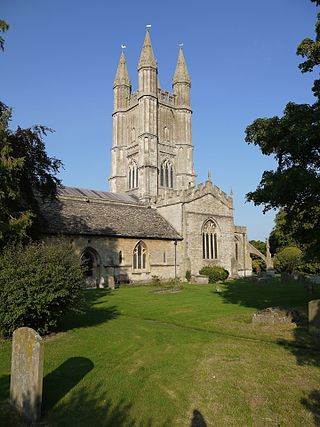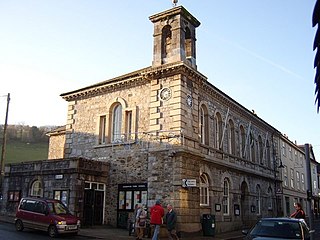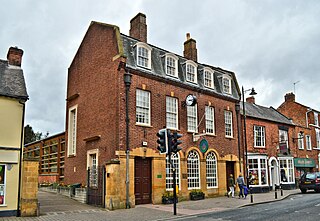
Cricklade is a town and civil parish on the River Thames in north Wiltshire, England, midway between Swindon and Cirencester. It is the first downstream town on the Thames. The parish population at the 2011 census was 4,227.
Cricklade railway station was on the Midland and South Western Junction Railway in Wiltshire, England. The station opened on 18 December 1883 on the Swindon and Cheltenham Extension Railway line from Swindon Town to the temporary terminus at Cirencester Watermoor. The S&CER line then amalgamated with the Swindon, Marlborough and Andover Railway to form the M&SWJR, and through services to the junction at Andoversford with the Great Western Railway's Cheltenham Lansdown to Banbury line, which had opened in 1881, began in 1891.

St Sampson's is the Church of England parish church of the town of Cricklade, Wiltshire, England. A large aisled church with a central tower, the present building dates from the late 12th century but has fragments of Anglo-Saxon work. The church is a Grade I listed building.

Wootton Bassett Museum is a local museum in the market town of Royal Wootton Bassett, Wiltshire, England. It is housed in the town hall which is a Grade II listed building.

Jenner's School is a Grade II* listed former school in Bath Road, Cricklade, Wiltshire, England. It was built in 1652 and then became a workhouse. It became a school again in the 19th century and is now a community hall.

Calne Town Hall is a municipal building in The Strand, Calne, Wiltshire, England. The town hall, which is the meeting place of Calne Town Council, is a grade II listed building.

Hartlepool Borough Hall is municipal building, which served as the meeting place of the old Hartlepool Borough Council, before it amalgamated with West Hartlepool County Borough Council. It is located on the Headland, Hartlepool in County Durham, England and is a Grade II listed building.

Ashburton Town Hall is a municipal building in the North Street, Ashburton, Devon, England. The town hall, which is the meeting place of Ashburton Town Council, is a Grade II listed building.

Chudleigh Town Hall is a municipal building in Market Way, Chudleigh, Devon, England. The town hall, which is the meeting place of Chudleigh Town Council, is a Grade II listed building.

Hadleigh Town Hall, also referred to as the New Town Hall, is a municipal building in the Market Place in Hadleigh, Suffolk, England. The building, which is the meeting place of Hadleigh Town Council, is a Grade II listed building.

Liversedge Town Hall is a former municipal building and town hall on Knowler Hill in the town of Liversedge, West Yorkshire, England. The building, which formerly operated as the offices of Liversedge Urban District Council, is now used as private residential accommodation.

Marlborough Town Hall is a municipal building in the High Street in Marlborough, Wiltshire, England. The structure, which is the meeting place of Marlborough Town Council, is a Grade II listed building.

Malmesbury Town Hall is a municipal building in Cross Hayes in Malmesbury, Wiltshire, England. The structure, which is the meeting place of Malmesbury Town Council and the home of the Athelstan Museum, is a Grade II listed building.

The Old Town Hall is a municipal building in the Market Place in Wilton, Wiltshire, England. The structure, which is currently used as a Baptist church, is a Grade II listed building.

Denny Town House is a municipal building in Glasgow Road, Denny, Falkirk, Scotland. The structure is used by Falkirk Council for the provision of local services.

Dalton Town Hall is a municipal building in Station Road, Dalton-in-Furness, a town in Cumbria, England. The building, which accommodates the offices and meeting place of Dalton-in-Furness Town Council, is a Grade II listed building.

Felling Town Hall, formerly Felling Council Offices, is a former municipal building in Sunderland Road, Felling, a district of Gateshead, in Tyne and Wear, England. The building, which is currently in residential use, is a Grade II listed building.

Pershore Town Hall is a municipal building in the High Street in Pershore, a town in Worcestershire, in England. Originally commissioned as a post office, it is now the headquarters of Pershore Town Council.

Cricklade Town Hall is an events venue in the High Street in Cricklade, a town in Wiltshire in England. It currently hosts a variety of community events, including a weekly cinema and annual school assemblies.

Clevedon Town Hall is a municipal building in Old Street in Clevedon, a town in Somerset in England. The building, which was commissioned as a primary school but currently accommodates the offices and meeting place of Clevedon Town Council, is a Grade II listed building.




















